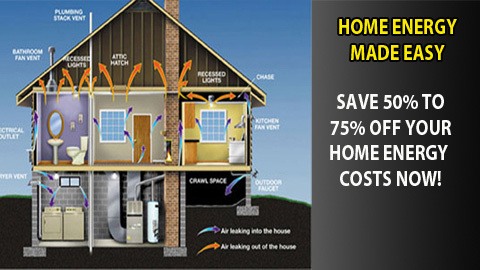A Guide to Air Sealing Your Home

This guide to air sealing your house is a practical strategy to lower heating expenses and enhance the comfort in your house is to lessen the quantity of air that leaks in and out. Many air sealing projects are best handled by a professional, although some air sealing techniques, including caulking and weather stripping, can be implemented as do-it-yourself chores. Prioritizing related activities can be facilitated by a professional energy evaluation.
Air sealing eliminates air leaks in the structure around the chimney, plumbing penetrations, and recessed lights, reducing drafts and heat loss. Caulk, spray foam, metal flashing, weather stripping, and rigid foam are among the materials used by professionals. Some materials are more suited to specific places or difficulty spots than others. In high-temperature air sealing conditions, such as around the chimney, fire-rated caulk and metal flashing are employed.
Air Sealing Techniques
While the solutions listed above cover many of the basic home sealing duties, there is much more that can be done to improve a home's sealing potential. Following are the recommended practices by professionals.
Understand the Sources
The first step toward establishing a solid foundation for air sealing is identifying where they are, which can be accomplished in a variety of ways. Aside from the methods listed above, doing a home pressurization test is a wonderful and effective way to discover air leaks in a home.

Repair the Major Issues
It is advised that you investigate attics, crawlspaces, and basements for air leaking potential first. While they may not be the most frequently used rooms in the house, air leaks in these rooms have the greatest impact on a home's energy efficiency.
Attics frequently release the most warm air of any room, whereas crawlspaces and basements are frequently the most vulnerable regions for cold air to enter the property. If you can only treat a few rooms in the house owing to financial or time constraints, starting with the attic or basement will be the most efficient use of your money.
Solving air leaking problems in these areas will have the most immediate and significant influence on a home's overall energy efficiency. Once these are finished, the rest of the house can be given attention. Of course, the best results occur when every room receives adequate air sealing enhancement, but the rooms mentioned above are the top priorities.
Cover All the Bases
After the major issue locations have been fixed, lesser air leaks throughout the property can be rectified. Consider implementing more visually appealing custom-fit solutions for minor air leaking areas. For example, foam gaskets can be used to supplement wall outlets for improved air sealing. Another option for tiny leaks and gaps in the building envelope is rubber foam weather seal tape.

Home Air Sealing
A typical household spends around $350 of its annual heating and cooling budget on air that seeps into or out of the house through unplanned gaps and crevices. You can plug many of those air leaks in home yourself with the money you waste in a single year. According to Energy Star, it is one of the most cost-effective ways to save energy and boost comfort.
Begin your air sealing your house project with the attic, which contains some of the most significant energy drains. Then tackle the basement to keep cold air from being sucked into the higher rooms. Finally, plug any remaining air leaks in the house. Here are good places to begin.
Air Sealing Attic
A 1/4” gap in an attic hatch or pull-down attic stairs lets the same amount of air to pass through as a bedroom heating duct. Caulk between the stair frame and the rough aperture, or put foam weatherstripping around the perimeter of the hatch hole, to seal it. Alternatively, you can buy a pre-insulated hatch cover system for stairs or doors.
Take Some Precautions Before Working in the Attic
If possible, do the required attic work on a cold day. Wear disposable clothing, gloves, and a double-elastic mask or a half-face respirator. Bring a droplight and at least two pieces of plywood large enough to span two or three joists to help you work. To avoid trips up and down a ladder, gather all of the things you'll need before you begin.
One word of caution: If you come across vermiculite insulation, wait until it has been tested for asbestos; your health department or air-quality agency can recommend a lab.

Air Sealing Windows
The most significant drafts in your home's primary living rooms tend to occur near windows and doors. If you have ancient windows, sealing and installing new weatherstripping will help to tighten them up. Bronze weatherstripping lasts for decades but takes time to apply, whereas other self-stick plastic versions are quick to install but don't last long.
Adhesive-backed EPDM rubber is a good compromise, with a life expectancy of at least ten years. Pulley seals prevent air from flowing through the openings where cords disappear into the frames. Weatherstripping is also useful for doors. Install a new door sweep if a draft is coming in from the bottom.
Air Sealing Basement
Low gaps in a foundation wall are important when attempting to repair a wet basement, but only those above the outside soil level allow air in. Caulk for gaps up to 1/4-inch wide and spray foam for larger gaps.
High-temperature caulk should be used around hot vent pipes, such as those for the furnace or water heater. Foam should be sprayed around larger holes for wires, pipes, and ducts that run through basement walls to the outside when air sealing your house.
Air leaks where the house framing sits on the foundation in most older houses with basements. Apply caulk between the foundation and the sill plate (the wood immediately above the foundation), as well as around the top and bottom edges of the rim joist (the piece sitting on top of the sill plate).

Final Word
Air leaks are difficult to detect, but indications include musty odors from the basement, drafty rooms, and ice dams. Spider webs are frequently used to identify areas of airflow in basements and crawl spaces. Act immediately once you notice signs of air leaks in home.

